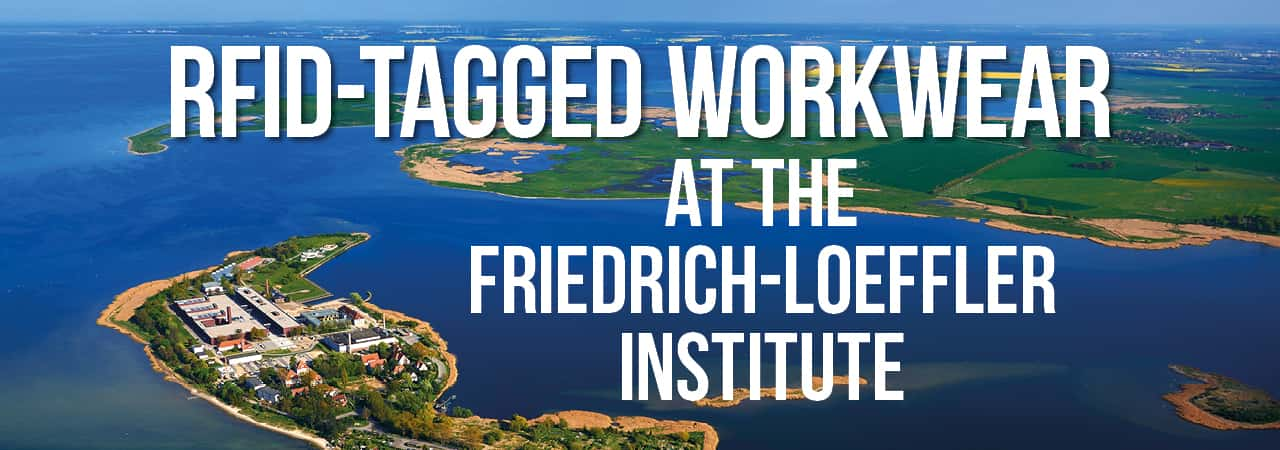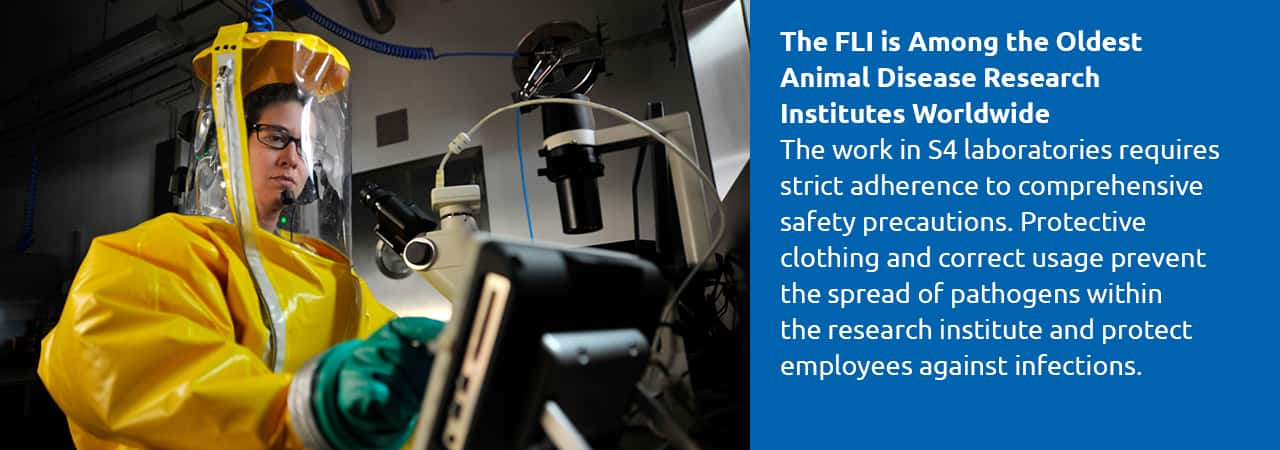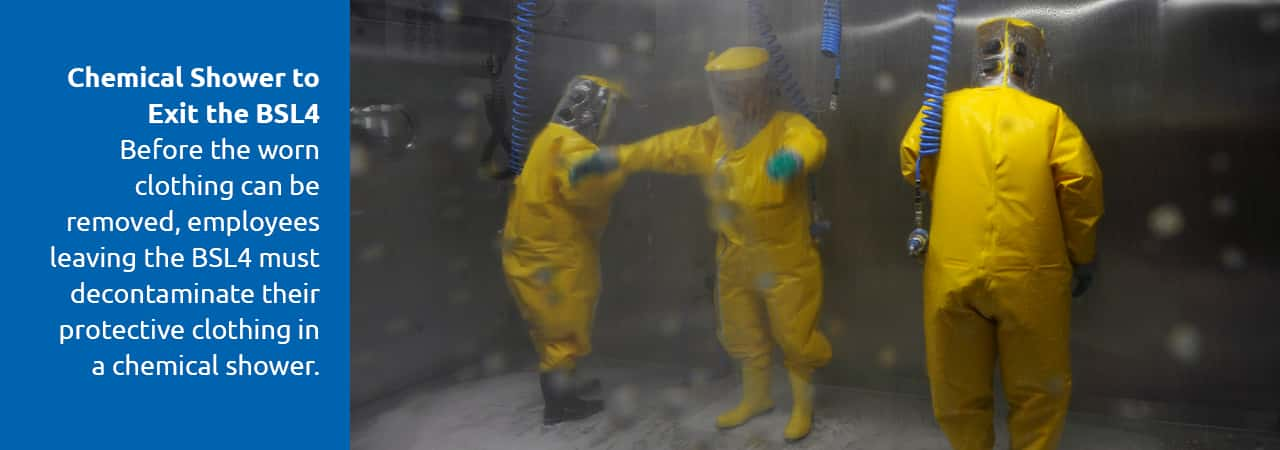Automated dispensing systems supply over 475 employees with HF-RFID-tagged work and protective clothing
Since 1910, the virological research facility 'Friedrich-Loeffler-Institut', Federal Research Institute for Animal Health, has been situated in the Greifswalder Bodden on the island of Riems, and is now the headquarters of five locations throughout Germany. Founder and namesake Friedrich Loeffler, discovered in 1898 that the foot-and-mouth disease is not caused by bacteria, but by viruses. Hence his reputation as the man who discovered viruses. The research laboratories meet the highest safety standards and are located in an animal disease restricted area
At the Friedrich-Loeffler-Institute (FLI) scientists are researching highly infectious viruses and bacteria that can infect animals. Research is also being conducted on zoonoses that are transmitted between animals and humans. Therefore, the corresponding laboratory facilities must meet the highest security requirements, up to security level S4. Throughout Germany, there are only four laboratories that have an S4 classification as a research institution. Supplying employees with protective equipment is also part of the safety concept.
RFID & Wireless IoT Global spoke to Maik Neubauer, head of a working group in the department for experimental animal husbandry and biosafety at FLI, about protective clothing and automated cabinet systems in the laundry dispensing area.
110 Years of Virological Research First Class in Europe Today
The FLI has a 350 square meter S4 zoonoses complex. The laboratory comprises a material sluice, an autoclave room, and other useful areas covering approximately 180 square meters. Unique to the European continent are two animal rooms measuring 66 square meters each. In these rooms, research on Ebola, Crimean-Congo hemorrhagic fever, and other S4 viruses in large animals such as pigs and cattle can be conducted. Comparable research is only possible in two other facilities worldwide: the National Microbiology Laboratory (NML), in Winnipeg/ Canada, and the Australian Animal Health Laboratory (AAHL), in Geelong/Australia.
Working on Zoonoses at Security Level S4
The realization of an S4 high-security laboratory for work dealing with zoonotic pathogens is only possible under special building and safety engineering conditions. The S4 complex is situated in a 'box-in-box' system. The S4 area is the inner box surrounded by an S3 area as the outer box. In order to work in the S4 area, scientific and technical personnel, and animal keepers must first pass through the S3 area in compliance with the safety and hygiene measures applicable to the respective areas before access to the S4 area is possible. All staff members work in a full protective suit, into which filtered air flows continuously through a hose with a safety valve.
There is a slight overpressure in the suit, so that no pathogens can penetrate it, even in the event of a leak. The entire building, on the other hand, is constantly under negative pressure so that the air flows in and can only reach the outside via high-performance HEPA filters. The incoming and outgoing air is filtered twice. All waste water from the laboratory and functional areas is collected in tanks installed under the laboratory. The wastewater is sterilized directly in the building before it is passed on to the institute's own wastewater treatment plant.
Cleaning of Workwear
Even if there is no risk of infection for humans when working with non-zoonotic animal pathogens, laboratory or stable wear must be worn in all security areas. Before entering a security area, street clothing is taken off in security airlocks and protective clothing is put on. If working with infected animals, a shower must be taken and the clothing changed again before moving to a new stable. These safety measures prevent the spread of pathogens within the stables and laboratories in a security area. Worn clothing and all solid waste is sterilized with hot steam (autoclaved) before it is disposed of or handed over to the textile service.
Worn workwear is processed in accordance with the requirements of the RAL-GZ 992/2 quality mark of the 'Sachgemäße Wäschepflege' (Quality Association for Proper Laundry Care). These specifications follow the regulations of the Robert Koch Institute for contaminated laundry to external service providers. The cleaning of all clothing and the supply of fresh laundry to the FLI is carried out by Textil-Service Mecklenburg.
Room or Cabinet Solution?
"Every possibility for the regulated distribution of work and protective clothing has been examined. The concept from ABG Systems was ultimately convincing, as the combination of hardware and software, as well as the interaction between cabinet solutions and a tunnel reader, proved to be a good fit. The implementation is very similar to a solution for clinics or medical facilities. However, what was most important for us was the combination of HF RFID, low space requirements, different sizes of dispensing compartments, hygienic individual delivery, and a tunnel reader," explains Maik Neubauer, working group leader in the Department of Experimental Animal Husbandry and Biosafety at FLI.
Four Laundry Machines for 475 Employees
"Since 2018, the Friedrich- Loeffler-Institute has had a central laundry dispensing system with four dispensing machines. In addition, decentralized laundry collectors and a central return tunnel have also been installed. Furthermore, bags with dirty laundry are scanned in a reading tunnel and the account is credited. The four dispensing machines provide a total of 956 individual dispensing compartments. From stockings, to underwear, to overalls, a total of 17 different items of laundry are offered in 10 sizes.
Altogether there are about 15,000 items of laundry with HF transponders in circulation. To avoid bottlenecks in the laundry supply and to ensure that every employee receives the required items at all times, the cabinets are stocked twice a day. The machines are available to the 475 employees around the clock, 365 days a year. There is no output limit," reports Maik Neubauer.
A Special Solution at the FLI
A special solution is used at the FLI to prevent the potentially contaminated garments from being handed over directly to the laundry service provider. All laundry items are autoclaved before transfer to the laundry and then identified outside the security areas in laundry bags through a stainless steel tunnel. In the RFID tunnel, laundry items are read and the employees' accounts are credited. All items of laundry are autoclaved before being handed over to the laundry. Cleaning is carried out according to RAL 992/2.
What Advantages Does the RFID Solution Create for the FLI?
"Each item of laundry is marked with an HF RFID transponder that conforms to data protection regulations. The main reasons for tagging are for the secure supply of the required work and protective clothing, the traceability of the laundry items and the optimized demand planning based on changing research priorities," explains Maik Neubauer. "If we achieve a reduction in shrinkage as a side effect, we are happy to accept it."
Looking at the data transparency provided by the exact tracking of individual items, Maik Neubauer adds: "We have identified a significant simplification in organizational structures and increased employee satisfaction as the main advantages of automated laundry dispensing.”
Source: RFID & Wireless IoT Global, Special Edition Laundry 2020






